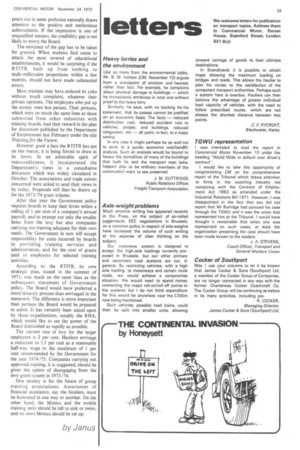Axle-weight problems
Page 49

If you've noticed an error in this article please click here to report it so we can fix it.
Much emotive writing has appeared recently in the Press, on the subject of so-called juggernauts. EEC negotiations in Brussels, on a common policy in respect of axle weights have increased the volume of such writing at the expense of clear thinking on the subject.
Our motorway system is designed to accept the high-axle loadings currently proposed in Brussels, but our other primary and secondary road systems are not, in general. By restricting vehicles, with a high axle loading, to motorways and certain trunk roads, we would achieve a compromise situation. We would need to spend money connecting the major roll-on/roll-off points to the systems but I do not think expenditure for this would be anywhere near the £200m now being mentioned.
Such vehicles, possibly road trains, could then be split into smaller units, allowing
onward carriage of goods to their ulitmate destinations.
In Scandinavia it is possible to obtain maps showing the maximum loading on bridges and roads. This allows the haulier to plan his routes to the satisfaction of the competent transport authorities. Perhaps such a system here is overdue. Hauliers can then balance the advantage of greater individual load capacity of vehicles, with the need to follow prescribed routes, which are not always the shortest distance between two points.
C. F. RYCROFT, Blackwater, Hants.












































































































